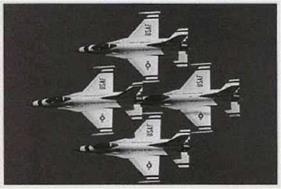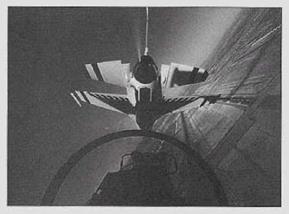Cloud Dancing: Air Shows and Aerobatics
|
|
 |
If you’re like me, you were bitten by the aviation bug the very first time you saw an ear-splitting formation of airplanes called the Thunderbirds. The U. S. Air Force’s Demonstration Squadron was created in the 1950s to lure young men to join the youngest of the armed services, but for me, and I’m certain for millions of other youngsters and not-so-youngsters, the Thunderbirds fueled my interest in civilian aviation.
The Thunderbirds, and their Navy counterpart group, the Blue Angels, may have beckoned plenty of young recruits into the service, but I’ll bet that half the cockpit seats in America’s jetliners are filled thanks to the breathtaking air show performances of the Thunderbirds, the Blue Angels, and scores of thrilling air-show performers.
No Business Like (Air)Show Business
The part of the Thunderbirds show that thrilled me years ago and that continues to get my heart pumping today: Partway through the show, the five jets fly away into the distance after performing a series of maneuvers. It seems as though the show is over.
|
The Thunderbirds were created to inspire young men and women to join the Air Force, but with their thrilling formation aerobatics, they also serve as emissaries of aviation of all kinds. (U. S. Air Force) |
But miles away, they turn back toward the airport in a tight arrowhead – shaped wedge and speed toward the crowd. With streams of smoke trailing behind, they get closer and closer while they fly lower and lower to the ground. Then, right at the center of the airport, the five jets pull sharply upward and split away from their tight formation, creating a starburst of smoke trails and an explosion of sound from the jet engines overhead.
|
By the Book The Thunderbirds arc the younger of the two military demonstration flight teams. The Navy Blue Angels began recruiting and good-will tours in 1946, shortly after World War II ended, because Navy brass feared the public would lose interest in military flying and might permit defense funding to be cut. The Air Force’s Thunderbirds took to the air in 1953, |
For me, it was the mixture of roaring engines, beautiful airplanes, and a hint of danger that sparked my imagination. That potent mixture has made air shows one of the most popular summertime events in the United States, and a crop of daring, highly skilled pilots have emerged to showcase one of the most thrilling faces of aviation— aerobatics.
Every weekend from late spring to early autumn—air show “season” pretty much mirrors baseball season—airports around the country, large and small, play host to air shows featuring some of the most breathtaking flying stunts you’ll see anywhere. From Patty Wagstaff, a slip of a woman who manhandles an airplane like no one in history, to Wayne Handley, who pilots the beefy, overpowered Turbo Raven, air-show pilots get up close and personal with aviation fans, often mingling in crowds and firing up enthusiasm in aerobatics.
|
Plane Talk |
In 19$2, the Thunderbirds suffered a tragedy that made some wonder if the boost to aviation was worth the danger of flying close-formation aerobatics. While performing a formation loop, the lead airplane suffered a mechanical failure. The formation airplanes, concentrating only on following the lead airplane, as they were trained, didn’t realize what was happening until it was too late to recover, despite the fact that they are in constant radio communication with each other and are trained for just such an emergency. Despite the tragic loss of life, military pilots saluted the formation pilots for their unblinking discipline in the cockpit Needless to say, the Thunderbirds team recovered from the disaster.
|
|
The Thunderbirds are famous for performing spectacular aerobatics at
near-supersonic speed while only inches apart. Here’s the incredible view
of what it looks like to fly at 600 miles per hour at arm’s length from
another plane.
(U. S. Air Force)
Air shows aren’t only about what’s going on in the sky. Some of the most popular air show stars aren’t the aerobatic pilots and planes, but the popular air show exhibits of the venerable war birds of World War II, which are still making the rounds thanks to dedicated mechanics and volunteers. Planes like the B-17 Sentimental Journey, and some of the memorable fighter planes of World War II, are on display at many air shows, as are exquisite antique civilian planes. Even the civilian classics are preserved so beautifully that they attract not only flying nuts but also antique auto buffs who appreciate historical vehicles that are lovingly maintained.
|
On Course When you watch the Thunder – birds and the Blue Angels fly through their routines, you’re seeing actual military maneuvers and techniques that have been choreographed for your entertainment The pilots are using the very same methods that their fellow pilots used to accomplish their missions in the Gulf War and during the Kosovo Crisis. |
|
Turbulence Aerobatics are a specialized form of flying and require special training by qualified pilots. Don’t try to fly aerobatic maneuvers unless you have this training. Nothing in this chapter should be regarded as encouraging pilots to fly aerobatic maneuvers. Acrobatics can place enormous strain on airplanes and on the human body, and can be deadly if not done correctly. |


















